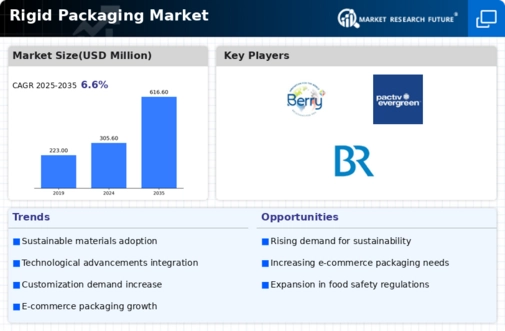-
Executive Summary
-
Scope of the Report
-
Market Definition
-
Scope Of The Study
- Research Objectives
- Assumptions & Limitations
-
Markets Structure
-
Market Research Methodology
-
Research Process
-
Secondary Research
-
Primary Research
-
Forecast Model
-
Market Landscape
-
Five Forces Analysis
- Threat Of New Entrants
- Bargaining power of buyers
- Threat of substitutes
- Segment rivalry
-
Value Chain of Global Rigid Packaging Market
-
Industry Overview of Global Rigid Packaging Market
-
Introduction
-
Growth Drivers
-
Impact analysis
-
Market Challenges
-
Impact analysis
-
Market Trends
-
Introduction
-
Growth Trends
-
Impact analysis
-
Global Rigid Packaging Market by Region
-
Global Rigid Packaging Market by Material
-
Global Rigid Packaging Market by Product
-
Global Rigid Packaging Market by Application
-
Company Profiles
-
Amcor Limited
- Overview
- Financials
- Product Portfolio
- Business Strategies
- Recent Development
-
Bemis Company Inc.
- Overview
- Financials
- Product Portfolio
- Business Strategies
- Recent Development
-
Berry Plastics Corporation
- Overview
- Financials
- Product Portfolio
- Business Strategies
- Recent Development
-
3M Company
- Overview
- Financials
- Product Portfolio
- Business Strategies
- Recent Development
-
Ball Corporation
- Overview
- Financials
- Product Portfolio
- Business Strategies
- Recent Development
-
Ardagh Group
- Overview
- Financials
- Product Portfolio
- Business Strategies
- Recent Development
-
Tray Pack Corporation
- Overview
- Financials
- Product Portfolio
- Business Strategies
- Recent Development
-
Nampak Ltd.
- Overview
- Financials
- Product Portfolio
- Business Strategies
- Recent Development
-
DS Smith Plc.
- Overview
- Financials
- Product Portfolio
- Business Strategies
- Recent Development
-
Sealed Air Corporation
- Overview
- Financials
- Product Portfolio
- Business Strategies
- Recent Development
-
Conclusion
-
LIST OF TABLES
-
World Population By Major Regions (2020 To 2027) (Million)
-
Global Rigid Packaging Market: By Region, 2022-2030 (Usd Million)
-
Global Rigid Packaging Market: By Region, 2022-2030 (Kt)
-
North America Global Rigid Packaging Market: By Country, 2022-2030 (Usd Million)
-
Europe Global Rigid Packaging Market: By Country, 2022-2030 (Usd Million)
-
Asia-Pacific Global Rigid Packaging Market: By Country, 2022-2030 (Usd Million)
-
RoW Global Rigid Packaging Market: By Country, 2022-2030 (Usd Million)
-
Global Rigid Packaging for Material: By Regions, 2022-2030 (Usd Million)
-
North America Global Rigid Packaging for Material: By Country, 2022-2030 (Usd Million)
-
Europe Global Rigid Packaging for Material Market: By Country, 2022-2030 (Usd Million)
-
Asia-Pacific Global Rigid Packaging for Material Market: By Country, 2022-2030 (Usd Million)
-
RoW Global Rigid Packaging for Material Market: By Country, 2022-2030 (Usd Million)
-
Global Rigid Packaging for Product: By Regions, 2022-2030 (Usd Million)
-
North America Global Rigid Packaging for Product: By Country, 2022-2030 (Usd Million)
-
Europe Global Rigid Packaging for Product Market: By Country, 2022-2030 (Usd Million)
-
Asia-Pacific Global Rigid Packaging for Product Market: By Country, 2022-2030 (Usd Million)
-
RoW Global Rigid Packaging for Product Market: By Country, 2022-2030 (Usd Million)
-
Global Rigid Packaging for Application: By Regions, 2022-2030 (Usd Million)
-
North America Global Rigid Packaging for Application Market: By Country, 2022-2030 (Usd Million)
-
Europe Global Rigid Packaging for Application Market: By Country, 2022-2030 (Usd Million)
-
Asia-Pacific Global Rigid Packaging for Application Market: By Country, 2022-2030 (Usd Million)
-
RoW Global Rigid Packaging for Application Market: By Country, 2022-2030 (Usd Million)
-
Global Material Market: By Region, 2022-2030 (Usd Million)
-
Global Application Market: By Region, 2022-2030 (Usd Million)
-
North America Global Rigid Packaging Market, By Country (Usd Million)
-
North America Global Rigid Packaging Market, By Material (Million Usd)
-
North America Global Rigid Packaging Market, By Product (Million Usd)
-
North America Global Rigid Packaging Market, By Application (Million Usd)
-
Europe: Global Rigid Packaging Market, By Country (Usd Million)
-
Europe: Global Rigid Packaging Market, By Material (Usd Million)
-
Europe: Global Rigid Packaging Market, By Product (Usd Million)
-
Europe: Global Rigid Packaging Market, By Application (Usd Million)
-
Asia-Pacific: Global Rigid Packaging Market, By Country (Usd Million)
-
Asia-Pacific: Global Rigid Packaging Market, By Material (Usd Million)
-
Asia-Pacific: Global Rigid Packaging Market, By Product (Usd Million)
-
Asia-Pacific: Global Rigid Packaging Market, By Application (Usd Million)
-
RoW: Global Rigid Packaging Market, By Country (Usd Million)
-
RoW: Global Rigid Packaging Market, By Material (Usd Million)
-
RoW: Global Rigid Packaging Market, By Product (Usd Million)
-
RoW: Global Rigid Packaging Market, By Application (Usd Million)
-
LIST OF FIGURES
-
Global Rigid Packaging market segmentation
-
Forecast Methodology
-
Five Forces Analysis of Global Rigid Packaging Market
-
Value Chain of Global Rigid Packaging Market
-
Share of Global Rigid Packaging Market in 2020, by country (in %)
-
Global Rigid Packaging Market, 2022-2030, (USD billion)
-
Sub-segments of Global Rigid Packaging Market
-
Global Rigid Packaging Market size by Material
-
Share of Metals in Global Rigid Packaging industry, 2022-2030
-
Share of Plasticsin Global Rigid Packaging industry, 2022-2030
-
Share of Glassin Global Rigid Packaging industry, 2022-2030
-
Share of Paperboardin Global Rigid Packaging industry, 2022-2030
-
Global Rigid Packaging Market size by Product
-
Share of Bottlesin Global Rigid Packaging industry, 2022-2030
-
Share of Cups & Tubsin Global Rigid Packaging industry, 2022-2030
-
Share of Traysin Global Rigid Packaging industry, 2022-2030
-
Global Rigid Packaging Market size by Application
-
Share of Food & Beverage in Global Rigid Packaging industry, 2022-2030
-
Share of Healthcare in Global Rigid Packaging industry, 2022-2030
-
Share of Personal Carein Global Rigid Packaging industry, 2022-2030
-
Share of Consumer goodsin Global Rigid Packaging industry, 2022-2030







Leave a Comment